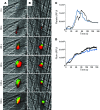Protein disulfide isomerase inhibitors constitute a new class of antithrombotic agents
- PMID: 22565308
- PMCID: PMC3366406
- DOI: 10.1172/JCI61228
Protein disulfide isomerase inhibitors constitute a new class of antithrombotic agents
Abstract
Thrombosis, or blood clot formation, and its sequelae remain a leading cause of morbidity and mortality, and recurrent thrombosis is common despite current optimal therapy. Protein disulfide isomerase (PDI) is an oxidoreductase that has recently been shown to participate in thrombus formation. While currently available antithrombotic agents inhibit either platelet aggregation or fibrin generation, inhibition of secreted PDI blocks the earliest stages of thrombus formation, suppressing both pathways. Here, we explored extracellular PDI as an alternative target of antithrombotic therapy. A high-throughput screen identified quercetin-3-rutinoside as an inhibitor of PDI reductase activity in vitro. Inhibition of PDI was selective, as quercetin-3-rutinoside failed to inhibit the reductase activity of several other thiol isomerases found in the vasculature. Cellular assays showed that quercetin-3-rutinoside inhibited aggregation of human and mouse platelets and endothelial cell-mediated fibrin generation in human endothelial cells. Using intravital microscopy in mice, we demonstrated that quercetin-3-rutinoside blocks thrombus formation in vivo by inhibiting PDI. Infusion of recombinant PDI reversed the antithrombotic effect of quercetin-3-rutinoside. Thus, PDI is a viable target for small molecule inhibition of thrombus formation, and its inhibition may prove to be a useful adjunct in refractory thrombotic diseases that are not controlled with conventional antithrombotic agents.
Figures









Similar articles
-
Protein disulfide isomerase as an antithrombotic target.Trends Cardiovasc Med. 2013 Oct;23(7):264-8. doi: 10.1016/j.tcm.2013.03.001. Epub 2013 Mar 27. Trends Cardiovasc Med. 2013. PMID: 23541171 Free PMC article. Review.
-
Thiol isomerases in thrombus formation.Circ Res. 2014 Mar 28;114(7):1162-73. doi: 10.1161/CIRCRESAHA.114.301808. Circ Res. 2014. PMID: 24677236 Free PMC article. Review.
-
Quercetin-3-rutinoside Inhibits Protein Disulfide Isomerase by Binding to Its b'x Domain.J Biol Chem. 2015 Sep 25;290(39):23543-52. doi: 10.1074/jbc.M115.666180. Epub 2015 Aug 3. J Biol Chem. 2015. PMID: 26240139 Free PMC article.
-
Formation of the clot.Thromb Res. 2012 Oct;130 Suppl 1(Suppl 1):S44-6. doi: 10.1016/j.thromres.2012.08.272. Thromb Res. 2012. PMID: 23026660 Free PMC article. Review.
-
Inhibition of Protein Disulfide Isomerase in Thrombosis.Basic Clin Pharmacol Toxicol. 2016 Oct;119 Suppl 3:42-48. doi: 10.1111/bcpt.12573. Epub 2016 Mar 23. Basic Clin Pharmacol Toxicol. 2016. PMID: 26919268 Review.
Cited by
-
Protein disulphide isomerase inhibition as a potential cancer therapeutic strategy.Cancer Med. 2021 Apr;10(8):2812-2825. doi: 10.1002/cam4.3836. Epub 2021 Mar 20. Cancer Med. 2021. PMID: 33742523 Free PMC article. Review.
-
Calcium Channel Blockade Ameliorates Endoplasmic Reticulum Stress in the Hippocampus Induced by Amyloidopathy in the Entorhinal Cortex.Iran J Pharm Res. 2019 Summer;18(3):1466-1476. doi: 10.22037/ijpr.2019.111532.13216. Iran J Pharm Res. 2019. PMID: 32641955 Free PMC article.
-
Exploring the Influence of Zinc Ions on the Conformational Stability and Activity of Protein Disulfide Isomerase.Int J Mol Sci. 2024 Feb 8;25(4):2095. doi: 10.3390/ijms25042095. Int J Mol Sci. 2024. PMID: 38396772 Free PMC article.
-
Biomechanical thrombosis: the dark side of force and dawn of mechano-medicine.Stroke Vasc Neurol. 2020 Jun;5(2):185-197. doi: 10.1136/svn-2019-000302. Epub 2019 Dec 15. Stroke Vasc Neurol. 2020. PMID: 32606086 Free PMC article. Review.
-
Synergies of phosphatidylserine and protein disulfide isomerase in tissue factor activation.Thromb Haemost. 2014 Apr 1;111(4):590-7. doi: 10.1160/TH13-09-0802. Epub 2014 Jan 23. Thromb Haemost. 2014. PMID: 24452853 Free PMC article. Review.
References
-
- Manickam N, Sun X, Li M, Gazitt Y, Essex DW. Protein disulphide isomerase in platelet function. Br J Haematol. 2008;140(2):223–229. - PubMed

